Abstract
Hybrid energy systems (HESs) generate electricity from multiple energy sources that complement each other. Recently, due to the reduction in costs of photovoltaic (PV) modules and wind turbines, these types of systems have become economically competitive. In this study, a mathematical programming model is applied to evaluate the techno-economic feasibility of autonomous units located in two isolated areas of Ecuador: first, the province of Galapagos (subtropical island) and second, the province of Morona Santiago (Amazonian tropical forest). The two case studies suggest that HESs are potential solutions to reduce the dependence of rural villages on fossil fuels and viable mechanisms to bring electrical power to isolated communities in Ecuador. Our results reveal that not only from the economic but also from the environmental point of view, for the case of the Galapagos province, a hybrid energy system with a PV–wind–battery configuration and a levelized cost of energy (LCOE) equal to 0.36 $/kWh is the optimal energy supply system. For the case of Morona Santiago, a hybrid energy system with a PV–diesel–battery configuration and an LCOE equal to 0.37 $/kWh is the most suitable configuration to meet the load of a typical isolated community in Ecuador. The proposed optimization model can be used as a decision-support tool for evaluating the viability of autonomous HES projects at any other location.
1. Introduction
Today, the world faces unprecedented environmental and economic challenges due to the unsustainable use of natural resources. The growth of the world population, the rising global energy demand, the depletion of conventional energy sources, and the volatility of fossil fuel prices have triggered the enthusiastic search for new alternative energy sources [1]. Renewable energy sources (RESs) have become an essential and promising option to face the abovementioned challenges [2,3,4]. As a result, in the last two decades, researchers, decision-makers, and industry leaders have prioritized the technological development and widespread deployment of low-carbon energy technologies [5]. Decentralized renewable units comprised of technologies such as wind turbines, photovoltaic (PV) solar panels, and micro-hydropower have been proposed as suitable solutions for a more sustainable and clean electricity supply [6,7,8]. However, despite the advantages of renewable energy technologies, the generation of electricity from RESs presents numerous challenges to their deployment, including policy barriers, technological barriers (e.g., intermittency and uncertainty due to its dependence on meteorological conditions, wind speed, or sunlight availability), and economic and financial barriers (e.g., high upfront costs, capital and operation costs) [4,9,10]. Hence, to provide a reliable and adequate electricity supply, there is a need for the hybridization of RESs with conventional generating sources [11].
Hybrid energy systems (HESs) generate electricity from multiple energy sources that complement each other. Historically, the global efforts to research and utilize these types of systems increased after the oil crisis in the early 1970s; since then, the number of HES installations has experienced a strong upsurge [12]. Generally, HESs incorporate one or more renewable energy sources (e.g., solar, wind, hydro, fuel cell), a conventional energy source (e.g., microturbines, gas turbines, and internal combustion engines), and an energy storage system, such as batteries, compressed-air energy storage (CAES) systems, flywheels, ultracapacitors, and superconducting magnetic energy storage (SMES) systems [13,14]. Furthermore, their configuration varies depending on their potential application, the availability of local resources, and the energy demand in a considered area. The basic components of an HES are shown in Figure 1.
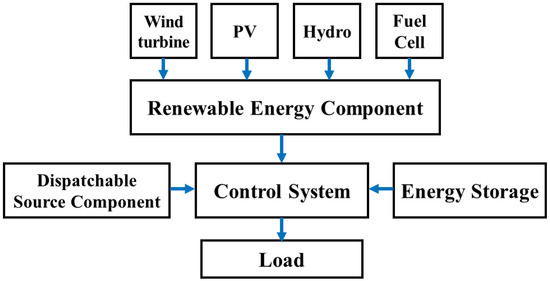
Figure 1.
Schematic representation of a hybrid energy system.
In the literature, HESs have been classified based on several criteria, such as types of technology, type of energy produced, capacity size, and level of integration with the grid [15]. Figure 2 shows an overview of the HES classifications. There are two main classifications of HESs on the basis of their interaction with the distribution grid. An HES that is connected to the distribution grid and that can buy (import) or sell (export) electricity is called an on-grid system. Conversely, an HES that is located in a remote area and therefore not connected to the distribution grid is called an off-grid system, also referred to as autonomous, standalone, or islandic. Another common classification of HESs is based on the criterion of installed capacity. HESs range from small-scale units with a few kilowatts to large-scale systems with enough capacity to power entire communities or industrial establishments. Small-scale hybrid energy systems have an installed capacity of less than 5 kW and are used for typical loads of remote homes, telecommunication systems, or meteorological stations. Medium-scale HESs have a capacity in the range of 5 to 100 kW and are used to electrify small communities in rural areas, isles, or mid-sized utilities. Lastly, large-scale HESs have an installed capacity greater than 100 kW and, in most cases, are connected to the distribution grid or the national grid [16].

Figure 2.
General classification of hybrid energy systems (HESs).
A particularly interesting feature of small- and medium-scale hybrid energy systems is their potential to supply electricity to remote unelectrified villages and rural areas in developing countries [17]. In 2018, the International Energy Agency (IEA) estimated that 992 million people did not have access to electricity and projected that by the year 2030, around 674 million would remain without access [18]. Consequently, local governments, international organizations, and private firms have developed a myriad of strategies and proposed numerous solutions aimed at expanding electricity services to households in remote villages. A conventional strategy is extending the national grid to the territories without electricity coverage. Unfortunately, this solution is prohibitively expensive, since the cost of transmission increases significantly with the remoteness of the location, and in most cases, it is impractical due to the small load demand of these regions [19,20]. Thus, a viable alternative solution that has been widely implemented for the electrification of rural areas in developing countries is the use of RESs to form hybrid energy systems [21].
An increasing number of articles report on the feasibility of hybrid energy power generation systems in developing countries. Particularly, there have been considerable efforts in the development of sizing methods and optimization techniques for these types of systems. For a comprehensive literature review encompassing the domains of optimization, planning, and sizing of hybrid energy systems, see [22,23,24,25]. The authors of [26] carried out a feasibility study of hybrid diesel–RES and grid–RES energy systems in the rural village of Sheikh Abolhassan, Iran. The study consisted of simulating different configurations of standalone HESs and evaluating the economic impact of grid connection and extension to the village with the use of the Hybrid Optimization Model for Electric Renewables (HOMER) computational tool. In [27], the authors applied a linear programming model for the study of hybrid off-grid energy systems in the unelectrified villages of Narendra Nagar, India, and Titutmate, Colombia. The proposed model served as a tool to understand the impact of crucial parameters such as fuel prices, load demand, and investment costs in the optimal configuration of the HESs. In [28], the authors used a simulated annealing (SA) algorithm-based chaotic search and harmony search to find the optimal size of a hybrid energy system while considering the total life cycle costs of a wind turbine, PV collectors, and an energy storage system. Their study focused on the remote region of Kerman, Iran, and the simulation was implemented in MATLAB. The authors of [29] presented an energy management strategy based on a receding horizon optimization (RHO) approach to determine the optimal capacity size of a hybrid renewable energy system (HRES) while satisfying the load demand and minimizing the operation, maintenance, and environmental costs. In the model, photovoltaic panels and wind turbines were considered as the main power technologies, with a diesel generator and a battery storage as backup units. Their study demonstrated the benefits of combining real-time weather forecasting, an RHO procedure, and a demand response strategy to increase the overall efficiency of the HRES.
In [30], the authors used a genetic algorithm (GA) to find the optimum capacity size of an autonomous HES comprised of photovoltaic (PV) panels, a backup source (either a microturbine or diesel generator) and a battery unit. The objective function minimized the overall production and emission costs while meeting the electricity demand of a small rural community located in Palestine. Their analysis indicated the importance of adequately designed HESs since they are capable of reducing not only energy costs but also greenhouse gas emissions. The authors of [31] investigated the potential application of a cuckoo search (CS) algorithm in finding the optimal size of a remote case study in Almora District of Uttarakhand, India. The CS algorithm performance was compared to other optimization algorithms like genetic algorithm and particle swarm optimization (PSO). Their results showed that CS algorithms outperform other well-known optimization methods due to their fast convergence. In [32], the authors focused on the feasibility study of an HES to supply electricity to a rural community in Santa Elena, Ecuador. By using the computational tool HOMER, the authors determined that the optimal HES configuration for the studied location comprised a PV array, wind turbines, a diesel generator, and a battery for electric storage.
The authors of [33] presented a PSO algorithm for the optimal sizing of a hybrid standalone power system and used empirical data from Ardebil, a province in Northwest Iran, to test the optimization model. The study proposed an approximate method for reliability evaluation and included a comprehensive reliability assessment of a hybrid wind/photovoltaic/fuel cell generation system. In [34], the authors proposed a linear programming formulation for the optimization of an autonomous energy system located in Lebanon (composed of wind, solar, diesel, and battery storage). In the study, various control policies and operation modes of diesel engines and batteries were evaluated. The authors of [35] simulated a PV/wind HES with battery storage in ARENA 12.0 software and compared its results to an optimization method using an SA algorithm. The study focused on an HES located in Turkey and provided a systematic approach for the design and evaluation of HESs. Moreover, their study suggested the use of loss of load probability (LLP) as a method to evaluate the autonomy of these types of systems. Besides the methods mentioned above, some other expert systems have been applied to determine the optimal component size, including iHOGA, Hybrid2, and HOMER [36,37,38]. Table 1 presents a summary of optimization techniques along with their area of study.

Table 1.
Techniques used for the optimization of HESs.
Although a large number of studies have reported on the feasibility of HESs in various regions of the world (for comprehensive reviews, see [13,39,40]), there is a gap in the literature on the potential of hybrid energy systems in Ecuador, in particular on the application of these types of systems for rural electrification. With this in mind, the purpose of this article is multifold. First, it presents a computable model that allows the determination of the capacity of each system component in an autonomous HES and, simultaneously, find the optimal operating schedule of the considered technologies. Second, on the methodological ground, the proposed model contributes to the literature by extending the linear problem formulation given in [27] and makes use of recent advances in the domain of subsystem component modeling described in [41,42,43,44]. Third, this paper extends the available literature related to the analysis of load profiles for remote areas. It considers the case of a rural community and formulates a load profile given the number of electrical appliances and usage habits of a low-income Ecuadorian household. Fourth, the proposed model is applied to investigate the potential of HESs to power off-grid, low-income communities in two regions of Ecuador, which is a relatively unexplored topic (in terms of innovative means for rural electrification).
The reminder of the paper is organized as follows: In Section 2, the problem definition is presented. In Section 3, the formulation of the computable model for optimal sizing and scheduling of autonomous HES is provided. The case studies and input data for the model are described in Section 4. Section 5 summarizes the model results of the two case studies. Finally, conclusions are presented in Section 6.
2. Problem Statement
As discussed in Section 1, this paper contributes to the existing literature by providing a framework capable of identifying the optimal component size and determining the optimal generation schedule of autonomous HESs. This is achieved through the formulation of an optimization model based on a linear programming (LP) approach. The objective function is defined as the minimization of the total life cycle cost (TLCC) of the HES, taking into account the technical constraints associated with each subsystem. Moreover, the model considers local meteorological and economic parameters. The model addresses the problem of the techno-economic feasibility of HES projects in isolated areas of Ecuador. To solve the abovementioned problem, the following simplifying assumptions are adopted:
- The hybrid energy systems are assumed to work independently and are expected to power isolated rural communities by supplying electricity in an efficient, reliable, and economical way.
- The optimization procedure is conducted over the period of one year with an hourly resolution.
- The meteorological conditions and electricity consumption values are kept constant within each one-hour time step.
- The hybrid energy systems may be comprised of solar-, wind-, battery-, and diesel-powered subsystems. Figure 3 shows a sample layout of a potential HES configuration.
 Figure 3. Configuration of an HES.
Figure 3. Configuration of an HES. - The annual meteorological conditions, load profiles, maintenance, and capital costs are considered to be representative of each analyzed case. This allows to evaluate the economic feasibility of the project through the computation of the TLCC (total life cycle cost) of the system. A generic example of the energy usage of a typical household and a daily solar energy production profile are presented in Figure 4, illustrating the mismatch between energy supply and demand in an HES.
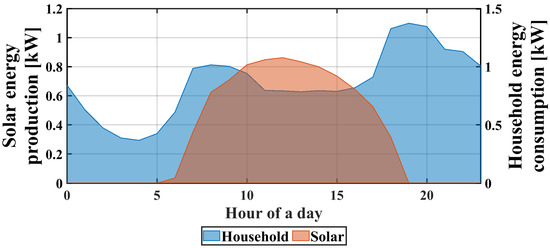 Figure 4. Energy consumption and solar energy production throughout a typical weekday.
Figure 4. Energy consumption and solar energy production throughout a typical weekday. - The generation of renewable energy technologies is based on hourly capacity factors. This is calculated considering the specific technical properties of each technology as well as hourly meteorological conditions.
3. Model Formulation
This section presents the mathematical model for the optimization of autonomous hybrid energy systems. The proposed linear programming model is an extension of the one developed by [27], and it is built upon the formulations presented in [41,42,43,44]. A new feature in our model is the direct inclusion of the total life cycle cost (TLCC) incurred by each technological component in the objective function. With these new cost elements, the model can be used to obtain the minimum levelized cost of energy (LCOE) and define the optimal capacity of each subsystem and their optimal operation schedule. Similarly to [41], in this study, we assume that the annual electricity generated and the annual costs of production remain constant over the system’s lifetime. With this assumption and the calculation of a capital recovery factor (CRF), it is possible to allocate the results obtained from the optimization procedure for one year to the entire lifetime of the hybrid energy system. The CRF is determined by [45].
where is the interest rate, and is the project lifetime.
The objective function of the model is presented in Equation (2). It minimizes the total life cycle costs of the HES. In this equation, TLCC is calculated as the sum of life cycle costs (in USD) of each power-generating technology ()plus the life cycle costs of the batteries ().
The total life cycle costs of the photovoltaic ( and wind () power generation subsystems are determined by Equations (3) and (4). The TLCCs of these technologies include capital costs ( and in ) and annual operation and maintenance costs ( and ; these costs are estimated as a fixed percentage of the capital costs ). The capital costs of the DC-to-AC inverter and other electrical and electronic equipment, as well as the inverter replacement costs, are included in [41]. The abovementioned costs are multiplied by the variables representing the installed capacity of each specific technology ( and in ).
The total life cycle cost of the diesel generator subsystem () is given in Equation (5). Analogous to the of the solar and wind-powered subsystems, includes the capital costs in maintenance costs as a percentage of the capital costs , and variable production costs [27,41]. Similar to other works [46], the variable production costs are determined by the diesel generator power output in , diesel price () in , and the efficiency of the diesel generator ().
The total life cycle cost of the battery subsystem () is specified by the capital costs, maintenance costs , and operating costs. The total operating costs are calculated by considering the annual operating cost of the battery (, in ) and the sum of energy charged and discharged ( during the year. Moreover, it is assumed that the battery bank will need to be replaced once throughout the system’s lifetime (after 10 years); hence, the includes a one-time replacement cost which is equivalent to the capital cost discounted to its present monetary value [47]. is defined using Equation (6) [41]:
The minimization of the is subject to constraints (7)–(13). Equation is the energy balance which states that the energy produce d by each technology and the energy flow from ) and to the battery must satisfy the hourly energy demand :
Equation (8) restricts the power output of each technology . This limit is defined as the product of the installed capacity and the capacity factor :
The capacity factor used in this study is defined as the fraction of the installed capacity of each technology that is available at the time segment [27]. Since the operation of the diesel generator is independent of the meteorological factors, and technical interruptions are not taken into consideration, the capacity factor for this technology is set to 1 for every time segment .
For photovoltaic and wind-powered technologies, the capacity factors are calculated beforehand according to (9) and (10). The capacity factor of the PV subsystem is calculated as the ratio of the solar irradiation incident on the PV array to the incident irradiation at standard test conditions ) for each time segment [42,43]. This is given by Equation (9). The effect of temperature on the PV array is neglected, and it is assumed that for a typical flat-plate module the incident irradiation at standard conditions is 1 kW/m2 [48].
The wind subsystem capacity factor is based on the simplifying assumption proposed by [44] and is calculated as follows:
where is the wind speed in , is the cut-in speed, is the rated speed, and is the cut-out speed.
Equations (11) and (12) relate the capacity of the electrical storage subsystem () to the capacity factor of this technology, which in this case is the depth of discharge . The depth of discharge is defined as the ratio of the discharged energy in to the usable capacity of the battery , usually ranging 80–100% for Li-ion batteries [49]. It is modeled to reduce the degradation of the battery by increasing the number of available life cycles. The restriction on the energy flow from the battery is given by Equation (11), and the restriction on the energy flow to the battery is given by Equation (12) [27]. The battery charge and discharge efficiencies are considered in the model and allow the battery round-trip efficiency to be determined.
The storage level at the time segment is equal to the energy stored at the beginning of the previous hour plus the net energy charged minus the energy released ) to cover the energy demand.
To compare the competitiveness of the analyzed HESs to other alternative solutions, the levelized cost of energy is calculated using Equation (14). The is usually referred to as the price at which electricity must be sold to break even [50].
A flowchart of the methodological framework proposed in this paper is provided in Figure 5. It shows the importance of the construction of the mathematical equations and the input data (economic, meteorological, and technical data of the system) on the modeling and design of hybrid energy systems. These two elements are essential for the optimization process. The mathematical model was implemented in General Algebraic Modeling System (GAMS) 27.1.0 and solved using the CPLEX 12.9.0.0 solver [51]. The model’s output was exported to a spreadsheet software, and MATLAB 2019a was employed for data structuring, postprocessing, and plotting. Finally, the numerical and graphical results of the optimization process were compiled and analyzed.

Figure 5.
Flowchart of the optimization process.
4. Selected Sites in Ecuador
Compared to other countries of Latin America, there is a limited body of literature that explores the potential as well as the implementation of HESs in Ecuador [52]. Therefore, the proposed optimization framework is used to evaluate the techno-economic feasibility of autonomous hybrid energy systems located in two isolated areas of this country, one in the Amazonian tropical forest and one on a subtropical island. The selected areas are in the provinces of Morona Santiago and Galapagos. While the former has one of the lowest national electrification rates and is inhabited by small, isolated, dispersed indigenous communities [53], the latter has only recently introduced local environmental policies aimed at promoting the implementation of an HES based on renewables, seeking to achieve a zero-emission fossil fuels objective [54]. Grid extension in these two provinces has been insufficient due to the difficult geographical conditions, inadequate infrastructure, and high investment costs. Nonetheless, in recent years, the Ecuadorian government, in coordination with international agencies, has proposed the use of distributed renewable energy technologies as mechanisms to expand the electricity access to isolated communities in the Andean and Amazonian regions [55].
Moreover, in the last decade, Ecuador has experienced profound changes in its energy sector. The country is transitioning from a fossil-fuel-based energy system to a sustainable system where renewable electricity sources account for approximately 60% of the total installed capacity. The Ecuadorian government invested nearly USD 6 billion in eight different projects comprised of run-of-river and flexible reservoir systems [56,57,58]. While hydropower constitutes the bulk of Ecuador’s installed capacity, resources like solar and wind have had little penetration in the Ecuadorian energy mix, mainly due to policy barriers and limited funding for emerging technologies. Despite the few solar and wind energy systems in the country, Ecuador has a high solar resource potential, with an average solar insolation of 4575 Wh/m2/day, and an available wind potential of 1.6 GW [58]. Hence, the deployment of renewable energy systems may be an effective instrument to increase the electrification of isolated regions in the country. Figure 6 shows the (a) solar and (b) wind potential maps of Ecuador. In this study, the meteorological data, including global horizontal irradiation (GHI) and wind speed of the two selected sites were obtained from the National Solar Radiation Database (NSRDB) [59]. The data sets are for one full year with an hourly resolution.
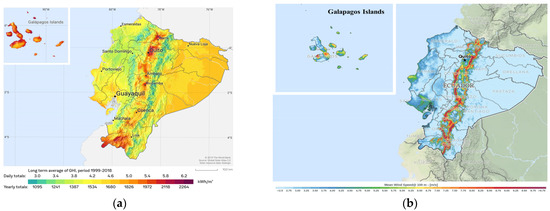
Figure 6.
Renewable energy potential in Ecuador: (a) Global Horizontal Irradiation map. Adapted from © 2019 The World Bank, Source: Global Solar Atlas 2.0, Solar resource data: Solargis [60]; (b) Mean wind speed map. Adapted from © 2019 Technical University of Denmark, Source: Global Wind Atlas 3.0, Wind resource data: Vortex [61].
The geographical locations of the selected areas in the provinces of Morona Santiago and the Galapagos Islands are characterized by high solar resource potential [56] and therefore suitable for the deployment of off-grid photovoltaic systems. In terms of wind power conditions, the selected site in Morona Santiago presents significantly lower mean wind speeds than those recorded in the Galapagos Islands. This is due to the contrasting climatic regions of Ecuador and of the two analyzed areas. The coastal and marine environment in the Galapagos Islands favors the deployment of small, low-wind-speed turbines [62], whereas, in the province of Morona Santiago, the low wind velocities make the application of wind-powered technologies less effective. The average monthly wind speeds and global horizontal irradiation of the considered site in the Galapagos province are shown in Figure 7.
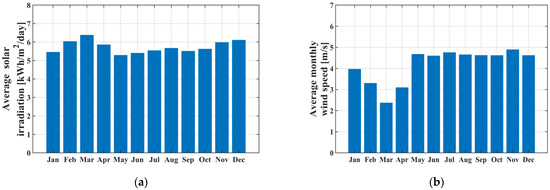
Figure 7.
Meteorological conditions at the considered site in the Galapagos province: (a) average daily solar irradiation; (b) average monthly wind speeds.
Numerous works have studied the energy use and daily demand patterns of rural households across Latin America [63]. For both case studies, the daily load profile of a low-income rural consumer is generated with the use of LoadProGen, a novel MATLAB tool that uses a bottom-up stochastic approach for the development of load profiles of off-grid systems for rural electrification [64]. Information on the number of electrical appliances and usage habits—including appliance functioning times and functioning windows—of low-income households living in isolated communities in Ecuador were obtained from [65,66] to compute the daily load profile. Furthermore, based on [66], it is assumed that the unelectrified community is composed of 30 houses, with a typical household consisting of five people. Table 2 summarizes the number of appliances and their average total daily time of use.

Table 2.
Number of appliances and their average total daily time of use in a typical household.
The techno-economic parameters of the constituent technologies are presented in Table 3, and the technological specifications and assumptions used in the model are shown in Table 4.

Table 3.
Techno-economic parameters of the considered technologies.

Table 4.
Technological specifications used in the model.
5. Results
As previously mentioned, in this paper, a mathematical programming model was employed to determine the optimal configuration and generation schedule of two autonomous hybrid energy systems. The systems were assumed to serve over a lifetime of 20 years, with an 8.6% annual interest rate. Two case studies were carried out using data from sites located in the provinces of (i) Morona Santiago and (ii) Galapagos, Ecuador. System configurations such as diesel, diesel–PV, diesel–wind, diesel–battery, diesel–wind–battery, diesel–PV–battery, PV–battery, PV–wind–battery, and diesel–PV–wind–battery were assessed for each site. The subsections below show the results of the model computed for both cases.
5.1. Galapagos Province
Table 5 summarizes the outputs of the model for the hybrid energy project located in the Galapagos province. The results show that a diesel–PV–wind–battery system leads to the lowest value of LCOE (0.30 $/kWh) and a total life cycle cost of approximately $36,352. The system consists of a 1.27 kW diesel generator, a 5.46 kW PV array, a 2.84 kW wind turbine, and a 29.72 kWh battery. In this system, renewable energy sources contribute nearly 95% (63% PV and 32% wind turbine) of the total power generation, while the diesel generator meets the remaining 5%. It is worth noting that in 2007, the Ecuadorian government launched the “Zero Fossil Fuels” initiative in the Galapagos Islands [54], a program aimed at decreasing the use of fossil fuels in electricity generation. Therefore, even though a PV–wind–battery configuration does not lead to the lowest LCOE (0.36 $/kWh) due to its high investment costs, it is reasonable to assume that this configuration should be considered as the optimal case for the Galapagos Islands. Table 5 also shows the annual CO2 emissions from the combustion of diesel fuel for all the configurations analyzed. As can be seen from the table, the hybridization of energy sources has a substantial impact on the TLCC and their respective emissions. In comparison to the diesel-only system, the diesel–PV–wind–battery configuration emitted nearly 13 times less CO2. Figure 8 shows the component capacities of the different system configurations.

Table 5.
Hybrid energy system configurations for the province of Galapagos.
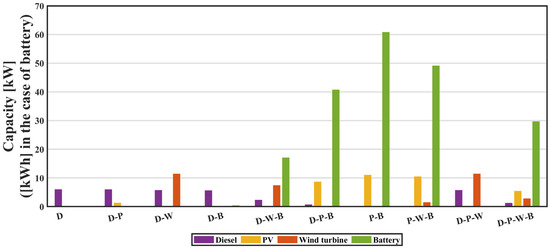
Figure 8.
Optimization results for the province of Galapagos.
The results also reveal that a system configuration comprised of a standalone diesel or a diesel–battery system leads to an LCOE of 0.69 $/kWh. For both cases, a 6 kW diesel generator would be required to meet the load demand of a typical low-income unelectrified village. However, the combination of a wind turbine with a diesel generator reduces the LCOE and TLCC by nearly 33%. For this configuration, 84% of electricity is generated by the wind subsystem, and the diesel generator serves as a secondary source of electricity.
Figure 9 presents the estimates of the TLCCs for each system configuration, including capital and O&M costs. In the case of a standalone diesel generator, capital costs represent 2.6% of the TLCC, and the remaining 97.4% is related to fuel and maintenance costs. For the configuration comprised of a diesel generator and PV–wind–battery subsystems, the majority of the capital costs are split between the battery, PV module, and wind turbine (49%, 29.2%, and 19.9%), while the fueling costs of the diesel generator represent the largest share of O&M costs (62.7%). Such results highlight the importance of RESs and their significant impact on the TLCC of a hybrid energy system.
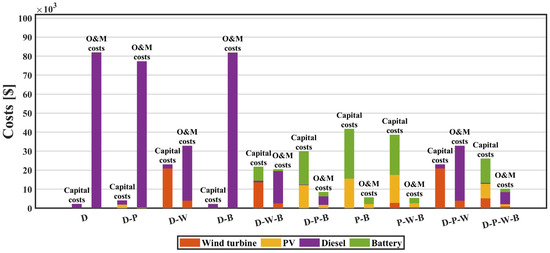
Figure 9.
Capital and O&M costs of each system configuration for the province of Galapagos.
The model proposed in this study is capable of providing an optimal operating schedule for the considered technologies in addition to determining the appropriate capacity of each component. Figure 10 illustrates the optimal power generation of the Diesel–PV–Wind–Battery (D-P-W-B) system configuration for 24 h. It can be observed that the solar-powered subsystem can generate electricity between 6 AM and 6 PM, with its highest output in the middle of this period. Most of the surplus energy is stored in the battery, which is later discharged and backed up by the diesel generator. The figure shows the battery storage depth of discharge, which, in the case of this study, was set to be 90%.
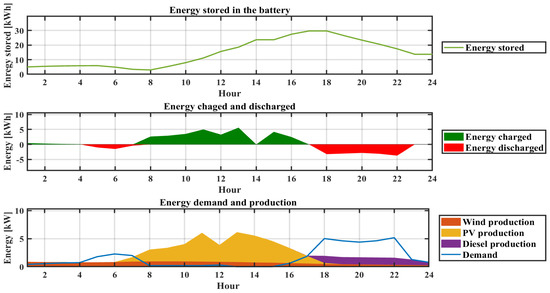
Figure 10.
Energy generation mix (Diesel–PV–Wind–Battery (D-P-W-B) system configuration) over a 24-h period in the Galapagos province.
5.2. Morona Santiago Province
The meteorological conditions in the province of Morona Santiago differ substantially from those in the Galapagos Islands. While the annual average wind speed in the province of Galapagos is around 4 m/s, the annual average wind speed in the Amazonian tropical forest is approximately 1 m/s. The results in Table 6 and Figure 11 show that the significantly lower wind speeds in the province of Morona Santiago excluded the wind power sources from the optimal HES configuration. In the system configuration powered only by a diesel generator, the LCOE (0.69 $/kWh) and TLCC ($84,221.42) are roughly the same as in the case of the Galapagos Islands. However, the optimization results show that the usage of PV and battery in the optimal design of the HES leads to a lower LCOE. A diesel–PV–battery system with a TLCC of $45,035.31 and comprised of a 0.8 kW diesel generator, an 11.38 kW PV array, and a 39.95 kWh battery results in the lowest LCOE, roughly 0.37 $/kWh. This is 15.6% higher than the LCOE of the diesel–PV–battery system in the Galapagos Islands. In the province of Morona Santiago, the solar irradiation is lower than in the Galapagos Islands, so the evident cost difference is due to the higher PV capacity of the system.

Table 6.
Hybrid energy system configurations for the province of Morona Santiago.
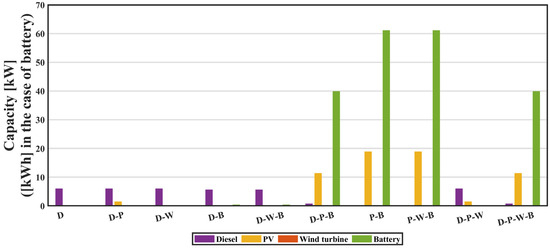
Figure 11.
Optimization results for the province of Morona Santiago.
Analogous to the case of the Galapagos Islands, the hybridization of energy sources resulted in a significant reduction of CO2 emissions. Although the emissions of a diesel–PV–wind–battery standalone power system in Morona Santiago are slightly higher than a similar system in the Galapagos Islands (because of the low wind speeds in the area), the results presented in Table 6 show that the application of these technologies in Morona Santiago can help reduce the reliance of remote communities on diesel for power generation.
Figure 12 presents the capital and O&M cost of each system configuration. Fuel expenses constitute the majority of the O&M costs in most cases, yet the O&M costs drastically decrease for system configurations with solar power and battery storage subsystems. On the other hand, battery storage has a relatively high investment cost, and it accounts for nearly half of the TLCC in the HES powered by PV.
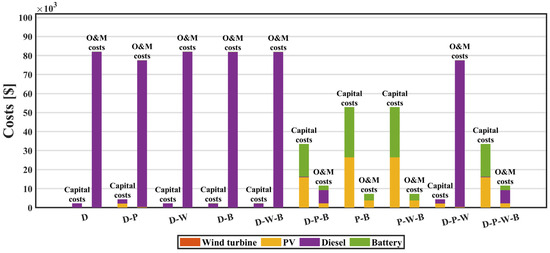
Figure 12.
Capital and O&M costs of each system configuration for the province of Morona Santiago.
6. Conclusions
This paper develops a techno-economic model based on a linear programming approach to optimize autonomous hybrid energy systems. The model has been implemented in the modeling language GAMS, and it is employed to determine the optimal component size and generation schedule of two independent HESs. The model considers investment, O&M, replacement, and fueling costs. Technical data such as component efficiencies, rated irradiation, rated wind speed, cut-in wind speed, and cut-out wind speed, as well as meteorological data (wind speed and irradiation), are used as input parameters. The model evaluation demonstrated that meteorological conditions are crucial during the design phase of an off-grid HES, but economic parameters (fuel prices and investment costs, among others) also have a significant impact on the optimal solution.
The model was applied to assess two different hybrid energy projects located in isolated areas of Ecuador, one in the Amazonian tropical forest and one on a subtropical island. The energy projects are expected to supply power to low-income households living in rural communities. Considering the economic and environmental aspects of the HES project located at the Galapagos province, the most cost-efficient system is comprised of a 10.51 kW PV array, 1.52 kW wind turbine, and 49.18 kWh battery. The computations showed that this system capable of providing electricity at an LCOE of approximately 0.36 $/kWh and a TLCC of $44,153. Although the entirety of the electricity is produced by RES, the lithium-ion battery storage provides flexibility and continuous service in times of unfavorable meteorological conditions. For the second case study, the HES project located in the province of Morona Santiago, the optimization model excluded the wind-powered subsystem due to the insufficient wind speeds. The optimized system configuration is comprised of a 0.8 kW diesel generator, 11.38 kW PV array, and 39.95 kWh battery; this configuration has an LCOE of 0.37 $/kWh and a TLCC of $45,035.
The results obtained from the application of the mathematical model developed in this study are in accordance with other sizing and optimization techniques commonly used for the feasibility analysis of renewable-energy-based hybrid systems. For example, [68,78,79] reported LCOE estimates ranging from 0.196 to 0.410 $/kWh. Furthermore, these studies also showed that the hybridization of energy sources in autonomous systems provides a substantial reduction of the total annualized costs and CO2 emissions.
To conclude, the case studies show that the proposed model adequately considers technical and economic constraints while minimizing the life cycle cost of the HES. Such a model is a step towards the development of computable models to foster global electrification, inclusive communities, and sustainable development. Currently, it constitutes an efficient and valuable decision-making tool in the sizing and scheduling of HESs.
Our results also demonstrate that the model presented in this study can be used as a building block for other optimization methods and simulation tools. For future research, the optimization model presented in this research will be extended to consider other techno-economic factors such as payment and tariff methods, taxes, distribution charges, and energy conservation methods. Moreover, the computable model will be compared with other optimization tools.
Author Contributions
Conceptualization, P.B., A.S., and J.K.; data curation, P.B. and A.S.; methodology, P.B., A.S. and J.K.; software, P.B. and A.S.; validation, P.B. and J.K.; writing—original draft preparation, P.B. and A.S.; writing—review and editing, P.B. and J.K.; visualization, P.B. and A.S.; supervision, J.K. All authors have read and agreed to the published version of the manuscript.
Funding
This research received no external funding.
Acknowledgments
This study was conducted within the statutory research of the Mineral and Energy Economy Research Institute of the Polish Academy of Sciences.
Conflicts of Interest
The authors declare no conflict of interest.
Nomenclature
| Sets | |
| Photovoltaic Diesel generator Wind turbine | |
| Time step (hours) | |
| Parameters | |
| Load demand at hour (kW) | |
| Annual maintenance cost of technology given as a fixed percentage of investment cost (%) | |
| Investment cost of technology ($/kW) | |
| Battery investment cost ($/kWh) | |
| Annual maintenance cost of battery given as a fixed percentage of investment cost (%) | |
| Battery operating cost ($/kWh) | |
| Battery replacement cost ($/kWh) | |
| Efficiency of technology (%) | |
| Battery charging efficiency (%) | |
| Battery discharging efficiency (%) | |
| Capacity factor of technology at hour | |
| Global solar irradiation at hour (W/m2) | |
| Standard global solar irradiation (W/m2) | |
| Wind speed at hour (m/s) | |
| Turbine cut-in wind speed (m/s) | |
| Turbine cut-off wind speed (m/s) | |
| Turbine rated wind speed (m/s) | |
| Diesel price ($/kWh) | |
| Inverter efficiency (%) | |
| Depth of discharge (%) | |
| Capacity recovery factor | |
| Lifetime (years) | |
| Interest rate (%) | |
| Variables | |
| Installed capacity of technology (kW) | |
| Battery capacity (kWh) | |
| Power output of technology at hour (kW) | |
| Amount of energy charged at hour (kWh) | |
| Amount of energy discharged at hour (kWh) | |
| Energy stored in the battery at hour (kWh) | |
| Total life cycle costs of the technology ($) | |
| Total life cycle costs of the battery ($) | |
| Total life cycle costs of the entire system ($) | |
Abbreviations
| CAES | Compressed-air energy storage |
| CRF | Capital recovery factor |
| CS | Cuckoo search |
| GA | Genetic algorithm |
| GAMS | General Algebraic Modeling System |
| HESs | Hybrid energy systems |
| HOMER | Hybrid Optimization Model for Electric Renewables |
| HRES | Hybrid renewable energy system |
| IEA | International Energy Agency |
| LCOE | Levelized cost of energy |
| LLP | Loss of load probability |
| LP | Linear programming |
| NSRDB | National Solar Radiation Database |
| PSO | Particle swarm optimization |
| PV | Photovoltaic |
| RES | Renewable energy source |
| RHO | Receding horizon optimization approach |
| SMES | Superconducting magnetic energy storage |
References
- Davis, S.J.; Lewis, N.S.; Shaner, M.; Aggarwal, S.; Arent, D.; Azevedo, I.L.; Benson, S.M.; Bradley, T.; Brouwer, J.; Chiang, Y.-M.; et al. Net-zero emissions energy systems. Science 2018, 360, eaas9793. [Google Scholar] [CrossRef] [PubMed]
- Chu, S.; Majumdar, A. Opportunities and challenges for a sustainable energy future. Nature 2012, 488, 294–303. [Google Scholar] [CrossRef] [PubMed]
- Panwar, N.L.; Kaushik, S.C.; Kothari, S. Role of renewable energy sources in environmental protection: A review. Renew. Sustain. Energy Rev. 2011, 15, 1513–1524. [Google Scholar] [CrossRef]
- Ellabban, O.; Abu-Rub, H.; Blaabjerg, F. Renewable energy resources: Current status, future prospects and their enabling technology. Renew. Sustain. Energy Rev. 2014, 39, 748–764. [Google Scholar] [CrossRef]
- Gielen, D.; Boshell, F.; Saygin, D.; Bazilian, M.D.; Wagner, N.; Gorini, R. The role of renewable energy in the global energy transformation. Energy Strateg. Rev. 2019, 24, 38–50. [Google Scholar] [CrossRef]
- Alstone, P.; Gershenson, D.; Kammen, D.M. Decentralized energy systems for clean electricity access. Nat. Clim. Chang. 2015, 5, 305–314. [Google Scholar] [CrossRef]
- Varun; Prakash, R.; Bhat, I.K. Energy, economics and environmental impacts of renewable energy systems. Renew. Sustain. Energy Rev. 2009, 13, 2716–2721. [Google Scholar] [CrossRef]
- Goldthau, A. Rethinking the governance of energy infrastructure: Scale, decentralization and polycentrism. Energy Res. Soc. Sci. 2014, 1, 134–140. [Google Scholar] [CrossRef]
- Heussen, K.; Koch, S.; Ulbig, A.; Andersson, G. Unified system-level modeling of intermittent renewable energy sources and energy storage for power system operation. IEEE Syst. J. 2012, 6, 140–151. [Google Scholar] [CrossRef]
- Eleftheriadis, I.M.; Anagnostopoulou, E.G. Identifying barriers in the diffusion of renewable energy sources. Energy Policy 2015, 80, 153–164. [Google Scholar] [CrossRef]
- Adefarati, T.; Bansal, R.C. Reliability, economic and environmental analysis of a microgrid system in the presence of renewable energy resources. Appl. Energy 2019, 236, 1089–1114. [Google Scholar] [CrossRef]
- Zhou, W.; Lou, C.; Li, Z.; Lu, L.; Yang, H. Current status of research on optimum sizing of stand-alone hybrid solar-wind power generation systems. Appl. Energy 2010, 87, 380–389. [Google Scholar] [CrossRef]
- Fathima, A.H.; Palanisamy, K. Optimization in microgrids with hybrid energy systems—A review. Renew. Sustain. Energy Rev. 2015, 45, 431–446. [Google Scholar] [CrossRef]
- Bizon, N.; Tabatabaei, N.M.; Shayeghi, H. Analysis, Control and Optimal Operations in Hybrid Power Systems; Springer: London, UK, 2013. [Google Scholar]
- Lazarov, V.; Notton, G.; Zahari, Z.; Bochev, I. Hybrid Power Systems with Renewable Energy Sources—Types, Structures, Trends for Research and Development. In Proceedings of the Eleventh International conference on Electrical Machines, Drives and Power Systems, Sofia, Bulgaria, 15–16 September 2005; pp. 515–520. [Google Scholar]
- Faccio, M.; Gamberi, M.; Bortolini, M.; Nedaei, M. State-of-art review of the optimization methods to design the configuration of hybrid renewable energy systems (HRESs). Front. Energy 2018, 12, 591–622. [Google Scholar] [CrossRef]
- Benalcazar, P.; Suski, A.; Kaminski, J. The effects of capital and energy subsidies on the optimal design of microgrid systems. Energies 2020, 13, 955. [Google Scholar] [CrossRef]
- International Energy Agency. Energy Access Outlook 2017: From Poverty to Prosperity; International Energy Agency: Paris, France, 2017. [Google Scholar]
- Almeshqab, F.; Ustun, T.S. Lessons learned from rural electrification initiatives in developing countries: Insights for technical, social, financial and public policy aspects. Renew. Sustain. Energy Rev. 2019, 102, 35–53. [Google Scholar] [CrossRef]
- Nema, P.; Nema, R.K.; Rangnekar, S. A current and future state of art development of hybrid energy system using wind and PV–solar: A review. Renew. Sustain. Energy Rev. 2009, 13, 2096–2103. [Google Scholar] [CrossRef]
- Ashok, S. Optimised model for community-based hybrid energy system. Renew. Energy 2007, 32, 1155–1164. [Google Scholar] [CrossRef]
- Anoune, K.; Bouya, M.; Astito, A.; Abdellah, A.B. Sizing methods and optimization techniques for PV–wind based hybrid renewable energy system: A review. Renew. Sustain. Energy Rev. 2018, 93, 652–673. [Google Scholar] [CrossRef]
- Siddaiah, R.; Saini, R.P. A review on planning, configurations, modeling and optimization techniques of hybrid renewable energy systems for off grid applications. Renew. Sustain. Energy Rev. 2016, 58, 376–396. [Google Scholar] [CrossRef]
- Sinha, S.; Chandel, S.S. Review of recent trends in optimization techniques for solar photovoltaic-wind based hybrid energy systems. Renew. Sustain. Energy Rev. 2015, 50, 755–769. [Google Scholar] [CrossRef]
- Lian, J.; Zhang, Y.; Ma, C.; Yang, Y.; Chaima, E. A review on recent sizing methodologies of hybrid renewable energy systems. Energy Convers. Manag. 2019, 199, 112027. [Google Scholar] [CrossRef]
- Asrari, A.; Ghasemi, A.; Javidi, M.H. Economic evaluation of hybrid renewable energy systems for rural electrification in Iran—A case study. Renew. Sustain. Energy Rev. 2012, 16, 3123–3130. [Google Scholar] [CrossRef]
- Huneke, F.; Henkel, J.; González, J.A.B.; Erdmann, G. Optimisation of hybrid off-grid energy systems by linear programming. Energy. Sustain. Soc. 2012, 2, 7. [Google Scholar] [CrossRef]
- Zhang, W.; Maleki, A.; Rosen, M.A.; Liu, J. Optimization with a simulated annealing algorithm of a hybrid system for renewable energy including battery and hydrogen storage. Energy 2018, 163, 191–207. [Google Scholar] [CrossRef]
- Wang, X.; Palazoglu, A.; El-Farra, N.H. Operational optimization and demand response of hybrid renewable energy systems. Appl. Energy 2015, 143, 324–335. [Google Scholar] [CrossRef]
- Ismail, M.S.; Moghavvemi, M.; Mahlia, T.M.I. Genetic algorithm based optimization on modeling and design of hybrid renewable energy systems. Energy Convers. Manag. 2014, 85, 120–130. [Google Scholar] [CrossRef]
- Sanajaoba, S.; Fernandez, E. Maiden application of Cuckoo Search algorithm for optimal sizing of a remote hybrid renewable energy System. Renew. Energy 2016, 96, 1–10. [Google Scholar] [CrossRef]
- Barzola, J.; Espinoza, M.; Cabrera, F. Analysis of Hybrid Solar / Wind / Diesel Renewable Energy System for off-grid Rural Electrification. Int. J. Renew. Energy Res. 2016, 6, 1146–1152. [Google Scholar]
- Kaviani, A.K.; Riahy, G.H.; Kouhsari, S.M. Optimal design of a reliable hydrogen-based stand-alone wind/PV generating system, considering component outages. Renew. Energy 2009, 34, 2380–2390. [Google Scholar] [CrossRef]
- Chedid, R.; Saliba, Y. Optimization and control of autonomous renewable energy systems. Int. J. Energy Res. 1996, 20, 609–624. [Google Scholar] [CrossRef]
- Ekren, O.; Ekren, B.Y. Size optimization of a PV/wind hybrid energy conversion system with battery storage using simulated annealing. Appl. Energy 2010, 87, 592–598. [Google Scholar] [CrossRef]
- Bekele, G.; Tadesse, G. Feasibility study of small Hydro/PV/Wind hybrid system for off-grid rural electrification in Ethiopia. Appl. Energy 2012, 97, 5–15. [Google Scholar] [CrossRef]
- Saiprasad, N.; Kalam, A.; Zayegh, A. Triple Bottom Line Analysis and Optimum Sizing of Renewable Energy Using Improved Hybrid Optimization Employing the Genetic Algorithm: A Case Study from India. Energies 2019, 12, 349. [Google Scholar] [CrossRef]
- Panahandeh, B.; Bard, J.; Outzourhit, A.; Zejli, D. Simulation of PV–wind-hybrid systems combined with hydrogen storage for rural electrification. Int. J. Hydrog. Energy 2011, 36, 4185–4197. [Google Scholar] [CrossRef]
- Upadhyay, S.; Sharma, M.P. A review on configurations, control and sizing methodologies of hybrid energy systems. Renew. Sustain. Energy Rev. 2014, 38, 47–63. [Google Scholar] [CrossRef]
- Bajpai, P.; Dash, V. Hybrid renewable energy systems for power generation in stand-alone applications: A review. Renew. Sustain. Energy Rev. 2012, 16, 2926–2939. [Google Scholar] [CrossRef]
- Malheiro, A.; Castro, P.M.; Lima, R.M.; Estanqueiro, A. Integrated sizing and scheduling of wind/PV/diesel/battery isolated systems. Renew. Energy 2015, 83, 646–657. [Google Scholar] [CrossRef]
- Abuelrub, A.; Singh, C. Planning of a hybrid energy system connected to a distribution system. In Proceedings of the 2017 IEEE Manchester PowerTech, Manchester, UK, 18–22 June 2017. [Google Scholar]
- Hiendro, A.; Kurnianto, R.; Rajagukguk, M.; Simanjuntak, Y.M. Junaidi, Techno-economic analysis of photovoltaic/wind hybrid system for onshore/remote area in Indonesia. Energy 2013, 59, 652–657. [Google Scholar] [CrossRef]
- Dhundhara, S.; Verma, Y.P.; Williams, A. Techno-economic analysis of the lithium-ion and lead-acid battery in microgrid systems. Energy Convers. Manag. 2018, 177, 122–142. [Google Scholar] [CrossRef]
- Tezer, T.; Yaman, R.; Yaman, G. Evaluation of approaches used for optimization of stand-alone hybrid renewable energy systems. Renew. Sustain. Energy Rev. 2017, 73, 840–853. [Google Scholar] [CrossRef]
- Van den Bergh, K.; Bruninx, K.; Delarue, E.; Dhaeseleer, W. A Mixed-Integer Linear Formulation of the Unit Commitment Problem. Work. Pap. 2014. Available online: https://www.mech.kuleuven.be/en/tme/research/energy_environment/Pdf/wpen2014-07.pdf (accessed on 23 May 2019).
- Bogaraj, T.; Kanakaraj, J.; Kumar, K.M. Optimal sizing and cost analysis of hybrid power system for a stand-alone application in Coimbatore region: A case study. Arch. Electr. Eng. 2015, 64, 139–155. [Google Scholar] [CrossRef]
- King, D.L.; Kratochvil, J.A.; Boyson, W.E. Temperature coefficients for PV modules and arrays: Measurement methods, difficulties, and results. In Proceedings of the Conference Record of the Twenty Sixth IEEE Photovoltaic Specialists Conference—1997, Anaheim, CA, USA, 29 September–3 October 1997; pp. 1183–1186. [Google Scholar]
- IRENA. Electricity Storage and Renewables: Costs and Markets to 2030; IRENA: Abu Dhabi, UAE, 2017. [Google Scholar]
- Hernández-Moro, J.; Martínez-Duart, J.M. CSP electricity cost evolution and grid parities based on the IEA roadmaps. Energy Policy 2012, 41, 184–192. [Google Scholar] [CrossRef]
- Brook, A.; Kendrick, D.; Meeraus, A. GAMS, a user’s guide. ACM SIGNUM Newsl. 1988, 23, 10–11. [Google Scholar] [CrossRef]
- IRENA. Renewable Energy Market Analysis: Latin America; IRENA: Abu Dhabi, UAE, 2016. [Google Scholar]
- ARCONEL. Estadística Anual y Multianual del sector eléctrico Ecuatoriano. Annu. Rep. 2016. Available online: https://www.regulacionelectrica.gob.ec/boletines-estadisticos/ (accessed on 23 May 2019).
- Llerena-Pizarro, O.R.; Micena, R.P.; Tuna, C.E.; Silveira, J.L. Electricity sector in the Galapagos Islands: Current status, renewable sources, and hybrid power generation system proposal. Renew. Sustain. Energy Rev. 2019, 108, 65–75. [Google Scholar] [CrossRef]
- European Commission; European Union. Programa EURO-SOLAR Síntesis Final Energía renovable para un desarrollo sostenible. Ref. Ares. 2013, 2014, 2463428. [Google Scholar]
- Cevallos-Sierra, J.; Ramos-Martin, J. Spatial assessment of the potential of renewable energy: The case of Ecuador. Renew. Sustain. Energy Rev. 2018, 81, 1154–1165. [Google Scholar] [CrossRef]
- Carvajal, P.E.; Li, F.G.N.; Soria, R.; Cronin, J.; Anandarajah, G.; Mulugetta, Y. Large hydropower, decarbonisation and climate change uncertainty: Modelling power sector pathways for Ecuador. Energy Strateg. Rev. 2019, 23, 86–99. [Google Scholar] [CrossRef]
- Ponce-Jara, M.A.; Castro, M.; Pelaez-Samaniego, M.R.; Espinoza-Abad, J.L.; Ruiz, E. Electricity sector in Ecuador: An overview of the 2007–2017 decade. Energy Policy 2018, 113, 513–522. [Google Scholar] [CrossRef]
- Sengupta, M.; Xie, Y.; Lopez, A.; Habte, A.; Maclaurin, G.; Shelby, J. The National Solar Radiation Data Base (NSRDB). Renew. Sustain. Energy Rev. 2018, 89, 51–60. [Google Scholar] [CrossRef]
- ESMAP; SOLARGIS; WB; IFC. Global Solar Atlas. 2019. Available online: https://globalsolaratlas.info/map (accessed on 23 May 2019).
- DTU Wind Energy; World Bank Group. Global Wind Atlas. 2018. Available online: https://globalwindatlas.info/ (accessed on 23 May 2019).
- Razmjoo, A.; Shirmohammadi, R.; Davarpanah, A.; Pourfayaz, F.; Aslani, A. Stand-alone hybrid energy systems for remote area power generation. Energy Rep. 2019, 5, 231–241. [Google Scholar] [CrossRef]
- Meier, P.; Tuntivate, V.; Barnes, D.F.; Bogach, S.V.; Farchy, D. Peru: National Survey of Rural Household Energy Use, Energy and Poverty Special Report 007/10; World Bank: Washington, DC, USA, 2010; Available online: https://www.esmap.org/sites/esmap.org/files/ESMAP_PeruNationalSurvey_Web_0.pdf (accessed on 23 May 2019).
- Mandelli, S.; Merlo, M.; Colombo, E. Novel procedure to formulate load profiles for off-grid rural areas. Energy Sustain. Dev. 2016, 31, 130–142. [Google Scholar]
- Porras, J. Estudio de Soluciones para Integración de Microproducciones en Redes Aisladas; Instituto Politecnico de Leira: Leiria, Portugal, 2017. [Google Scholar]
- Urdiales, L. Procedimiento para la Electrificacion en Zonas Aisladas: Caso canton Taisha, Morona Santiago; Universidad de Cuenca: Cuenca, Ecuador, 2015. [Google Scholar]
- IRENA. IRENA: Renewable Power Generation Costs in 2017. Int. Renew. Energy Agency 2018. Available online: https://www.irena.org/publications/2018/Jan/Renewable-power-generation-costs-in-2017 (accessed on 23 May 2019).
- Fodhil, F.; Hamidat, A.; Nadjemi, O. Potential, optimization and sensitivity analysis of photovoltaic-diesel–battery hybrid energy system for rural electrification in Algeria. Energy 2019, 169, 613–624. [Google Scholar] [CrossRef]
- Kolhe, M.L.; Ranaweera, K.M.I.U.; Gunawardana, A.G.B.S. Techno-economic sizing of off-grid hybrid renewable energy system for rural electrification in Sri Lanka. Sustain. Energy Technol. Assess. 2015, 11, 53–64. [Google Scholar] [CrossRef]
- Trading Economics, Ecuador Interest Rate. 2019. Available online: https://tradingeconomics.com/ecuador/interest-rate (accessed on 23 May 2019).
- Walker, A. PV O&M Cost Model and Cost Reduction; NREL: Lakewood, CO, USA, 2017.
- Predescu, M. Economic evaluation of small wind turbines and hybrid systems for residential use. Renew. Energy Environ. Sustain. 2016, 1, 33. [Google Scholar] [CrossRef]
- Naumann, M.; Karl, R.C.; Truong, C.N.; Jossen, A.; Hesse, H.C. Lithium-ion battery cost analysis in PV–household application. Energy Procedia 2015, 73, 37–47. [Google Scholar] [CrossRef]
- EP PETROECUADOR. Gerencia de Comercialización Nacional, Estructura de Precios Mayo. 2019. Available online: https://www.eppetroecuador.ec/wp-content/uploads/downloads/2019/05/ESTRUCTURA-DE-PRECIOS-MAYO-2019-MENSUAL-SNI-DEL-23-AL-29-DE-MAYO-2019.pdf (accessed on 23 May 2019).
- Ghafoor, A.; Munir, A. Design and economics analysis of an off-grid PV system for household electrification. Renew. Sustain. Energy Rev. 2015, 42, 496–502. [Google Scholar] [CrossRef]
- Wheeler, R.K. Efficient Operation of Diesel Generator Sets in Remote Environments; Virginia Polytechnic Institute and State University: Blacksburg, VA, USA, 2017. [Google Scholar]
- Advances in Wind Power; InTech: London, UK, 2012.
- Altun, A.F.; Kilic, M. Design and performance evaluation based on economics and environmental impact of a PV–wind-diesel and battery standalone power system for various climates in Turkey. Renew. Energy 2020, 157, 424–443. [Google Scholar] [CrossRef]
- Agyekum, E.B.; Nutakor, C. Feasibility study and economic analysis of stand-alone hybrid energy system for southern Ghana. Sustain. Energy Technol. Assess. 2020, 39, 100695. [Google Scholar] [CrossRef]
© 2020 by the authors. Licensee MDPI, Basel, Switzerland. This article is an open access article distributed under the terms and conditions of the Creative Commons Attribution (CC BY) license (http://creativecommons.org/licenses/by/4.0/).